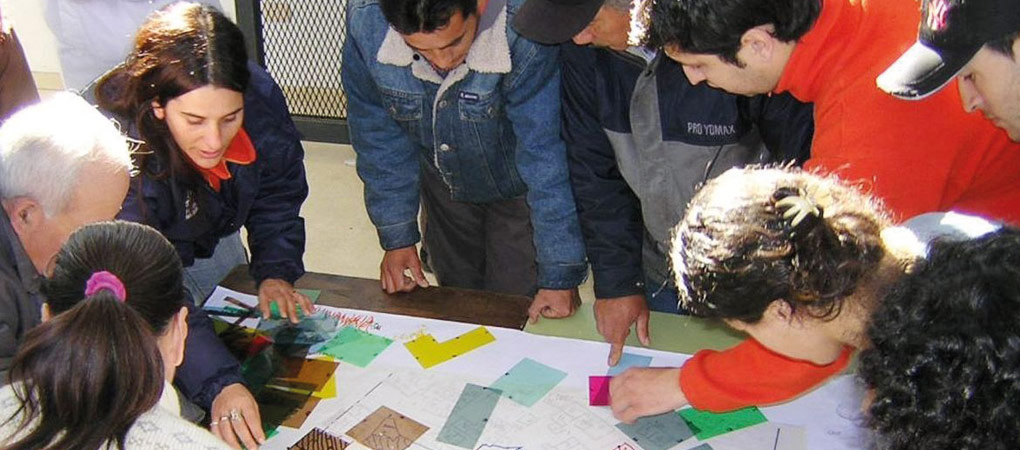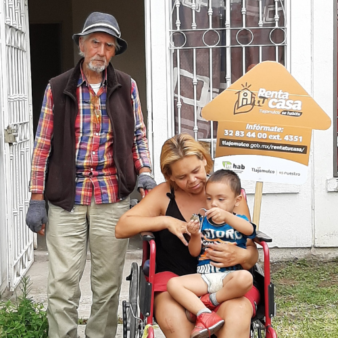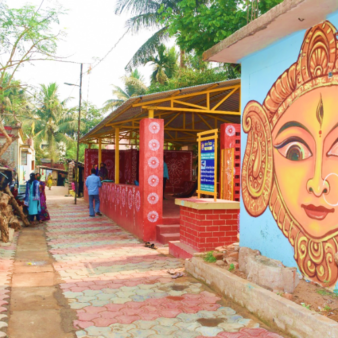Founded in 1927, the Public Housing Service (SPV) is a department of the Rosario municipal government, working within a system of decentralised management of resources. In addition to its urban upgrading activities and housing improvement programmes, SPV is involved in the construction of new housing units for low and moderate income households in Rosario, as well as land tenure regularisation. The Rosario Habitat programme has helped 5,298 families to upgrade their homes and strengthen their local economy and environment using participatory methods. The programme is expected to be scaled up and has already been transferred to other major cities in Argentina.
Project Description
Aims and Objectives
The main purpose of the programme is to improve the living conditions of low-income families living in informal settlements in the city of Rosario through a holistic, participatory process. In particular, the programme aims to ensure the rights of citizens to decent housing, secure land tenure and basic services through addressing issues of social exclusion and promoting the physical and social integration of informal settlement residents into the formal city.
Context
With more than one million inhabitants, Rosario is an important industrial city and the second largest urban centre in Argentina. Yet more than 100,000 residents live in informal settlements in conditions of extreme poverty, without access to adequate housing or basic services. When the Rosario Habitat programme began in 2000, there were 91 informal settlements in Rosario, covering 10% of the urban surface. Most of these had emerged decades earlier, with rural migration to the main urban centres during the process of industrialisation in Argentina. Others had grown as a result of intra-urban migration.
In addition to physical problems, such as the lack of adequate infrastructure (particularly piped water supply and sewage) and structural deficiencies resulting from homes being built without any technical assistance, the informal settlements in Rosario are characterised by overcrowding, high rates of crime and unemployment, and a lack of security of land tenure.
Key features
Rosario Habitat is a comprehensive informal settlement upgrading programme carried out by SPV in collaboration with a range of partners including residents’ associations and other community-based groups, NGOs and national and provincial government agencies. The programme combines infrastructure investments with social development initiatives, and legal actions with measures to create economic opportunities. All programmes are people-centred and aim to build relations among community members. The programme is working in eleven informal settlements in Rosario and comprises the following key components:
- New urban planning of the settlements – including the opening of roads and urban regularisation, ensuring the provision of basic infrastructure (water and electricity supply, sewage, storm drains, gas, paved roads) and community facilities.
- Housing improvements – ensuring satisfactory sanitary conditions through the construction of toilet facilities/sanitary units.
- Building houses with infrastructure – for families living in high risk areas and/or relocated as a consequence of the new urban planning (relocations should not exceed 30% of the total number of houses in each settlement).
- Legal regularisation – this includes the transfer of state-owned land to SPV, the purchase of private occupied plots, the demarcation of plots and the transfer of legal title to residents.
- Strengthening social networks – with a focus on the direct participation of residents in decision-making processes at all stages (planning, development and implementation).
- Risk prevention programmes – targeted specifically for children and youth (education, nutrition, counselling, etc.).
- Employment and income generation – training and work experience for 16-25 year olds and support in establishing social enterprise incubators, primarily benefiting female heads of households.
- Institutional strengthening – training for administrative and technical staff, technical assistance, monitoring and evaluation. The urban upgrading programme is carried out as part of a broader municipal process for social inclusion that involves participatory budgeting and an innovative urban agriculture programme.
Covering costs
The Inter-American Development Bank (IADB) has provided (via the Ministry of Federal Planning of the National Government) US$43 million of funding for the programme. This represents 60% of the total cost, with the Municipality of Rosario providing the remaining 40% of total funds (amounting to US$28.7 million). To date, 77% of the programme’s entire budget, or US$33.1 million, has already been disbursed.
Impact
A total of 3,813 families (72%) stayed in the original settlements, with improved housing conditions and infrastructure/services. In a post-occupancy survey, 83% of families stated that they were satisfied with the upgrading process. Beneficiaries especially appreciated improved access to the neighbourhood, new building of roads and passageways, quality of services rendered and increased security.
The remaining 28% of families (1,479) were relocated, and have received a house with basic infrastructure and services. Post-occupancy studies show that 86% of families are satisfied with the relocation process Residents report that their greatest source of satisfaction is having a house of their own.
The programme has generated important impacts in the wider community and city as a whole, with improvements in environmental quality, security, infrastructure, public services and traffic circulation. Two sports centres, two community centres, one training centre, three healthcare centres and three recreational squares have been built and are open for public use.
The regulatory framework governing land use was modified in order to adapt to the particular characteristics of the informal settlements and enable the approval of plans and land titling. A specific regulation was passed to authorise land plots and sub-divisions that respected the existing settlement, with the condition that the minimum area of each plot should be 100m2. New roads would have to be 18m wide and pedestrian streets 14m wide.
Why is it innovative?
- Developing effective mechanisms to ensure the active participation of residents at all stages of the project. The continuous revision and adaptation of the participatory methodologies and acting on residents’ feedback is critical.
- Institutional strengthening, in order to improve the skills and expertise of the SPV team. An important aspect of these efforts is adopting tools for the effective management of activities, including with respect to monitoring and evaluation.
- The decentralised structure of the SPV reduces administrative costs and allows the team to respond quickly to the requirements of the project and residents.
- Achieving high levels of credibility among residents and the wider community in the management of the project and quality of the physical upgrading work. There has been widespread recognition of the advantages of on-site upgrading rather than eradication.
- Developing a flexible regulatory system to enable the upgrading and regularisation of the informal settlements.
- There have been technical innovations in the provision of water supply and sewage services and prefabricated toilet facilities/units.
- The programme is part of an innovative process of social inclusion involving participatory budgeting and urban agriculture.
What is the environmental impact?
- The urban upgrading interventions are carried out in existing settlements, making use of and improving existing buildings and community infrastructure. For the construction of new housing and community facilities, the project uses conventional building materials, which are purchased from local suppliers. The prefabricated toilet/sanitary units are made of concrete and are produced in the local area, with the CASAPARTES Foundation of the Rosario National University.
- The programme provides residents with access to safe drinking water and improves existing urban infrastructure and services. Rather than being forced to move to distant areas without services and requiring long, polluting commutes to places of employment, the programme ensures that residents are able to stay in the area, both in the case of existing settlements and in relocation areas.
Is it financially sustainable?
- The project has been running successfully since 2001 and funding is in place for the remaining work to be completed by the end of 2011. There are plans for a second phase of the programme, which will have a similar funding structure. In terms of ongoing development and investments in Rosario, the city-wide participatory budgeting programme enables residents to identify priority areas and make key decisions as to the allocation of government resources.
- In addition to generating 150 construction and professional jobs, the programme provides training, technical and financial support in establishing social enterprises. To date, 920 micro-entrepreneurs have been trained, 560 of whom have developed micro-enterprise projects and received advice and economic support through micro-credit loans. A large proportion of the micro-entrepreneurs are female heads of household. An additional 370 projects are currently being considered for support.
- Whilst the programme does not specifically aim to increase housing affordability, but rather to improve living conditions of low-income families in informal settlements, access to decent housing and infrastructure is improved. Although this means families must pay for services, residents have not only done so but have also begun to improve their homes with their own funds.
What is the social impact?
- The programme works to promote social integration, developing participatory approaches and creating spaces for social interaction. Communities are involved in collective decision-making on planning and design as well as social and environmental issues, working together to achieve their goals, mobilise and build social networks.
- Social audits and mediation techniques have allowed neighbourhoods not only to complete their projects, but also to strengthen local networks and the future sustainability of community life.
- A number of capacity-building workshops are also carried out with residents on a range of subjects, such as planning, social and environmental issues, rights and responsibilities, setting priorities to address problems, income and job creation.
- Indicators show that security levels have substantially increased as a result of the programme and a post-occupancy survey showed that 74% of residents felt that security had improved in their neighbourhood.
- Gender equity is an important consideration in the programme and women have been actively involved throughout the process.
Barriers
- Difficulties were encountered regarding the availability of urban land plots for the construction of new housing for families needing to be relocated, as the process of acquiring either public land from the National Government or privately owned land is both complex and time-consuming. Families are relocated to areas as close as possible to the original settlement.
- In some communities problems were encountered with the supply of infrastructure (e.g. drinking water and sewage), leading to delays.
- Internal migration within the settlement, along with the movement of new residents into the settlement, have posed significant challenges. In order to address these issues, both individual and collective agreements needed to be reached (e.g. transferring benefits from one family to the next, having new families sign up to an agreed set of rules, etc).
- Changing economic scenarios over time (‘boom and bust’) have affected the project. Strategies have been created to address this challenge. For example, tendering for infrastructure was carried out separately from housing. In the case of home improvements, the work was carried out by cooperatives, with SPV responsible for managing the process and providing building materials.
Lessons Learned
- Winning the trust of residents is fundamental to success. Families had been socially excluded and living in precarious conditions for up to three or four decades. The key to the success of the programme was direct, honest communication with families, clarifying risks and steps to be taken, communicating achievements and involving the entire community in the decision-making process.
- If a conflict arises, increased participation is the best response. Residents were involved in mediation and negotiation processes, thus strengthening social networks and empowering residents to decide which solutions are best for their own problems.
- The formation of a Coordination Unit, comprising all of the municipal offices that participate in the project, has allowed the programme to cover a wide range of physical and social interventions throughout each specific area, increasing its impact.
- Flexible regulatory systems are necessary in order to be effective in the regularisation of the informal settlements. In this case, a decree was approved with more lenient conditions, tailored to the specific needs/characteristics of the settlements.
- The institutional continuity achieved, beyond an individual government term, allowed for the consolidation of a management model and a strengthening of the approach, helping to incorporate previous lessons and thus improve the actions taken.
- The need to take actions with immediate political impact, whilst contributing to an extent towards improving living conditions in the settlements, will not achieve the long-term objectives of the programme.
Evaluation
- Regular monitoring and evaluation of the programme interventions is carried out by SPV and the IADB and knowledge is systematised, with lessons learned from each project taken into account in the implementation of subsequent projects.
- Post-occupancy evaluations have also been carried out with residents, with positive results (see above).
Transfer
- The programme began in 2001 and now covers 11 informal settlements in the city of Rosario. There are plans for a second phase of the project, with a view to reaching an additional 7,500 low-income families. The programme itself draws upon lessons learned from other urban upgrading experiences also supported by the IADB, such as Favela-Bairro in Rio de Janeiro.
- The project has been highlighted by the national government as an example of good practice and the methods used in Rosario have been systematised to facilitate transfer to other communities.
- The approach has been transferred to the city of Buenos Aires (‘PROSUR’ programme) and is in the process of being transferred to Santa Fe (‘Habitat Santa Fe’ programme) by the Provincial Secretariat of Housing and Urban Development of Santa Fe and the Ministry of the Economy.
- There have been no international transfers as yet.
Partnership
Local community



